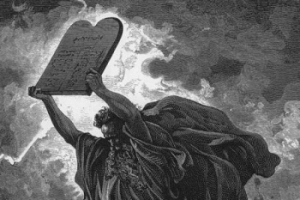
A Summary of Moses’ Life
Early Life in Egypt
Born into a humble Levitical slave family in Egypt, Moses’ life was immediately threatened when Pharaoh ordered all Hebrew male infants drowned in the Nile. Though his mother Jochebed hid him for three months, she was eventually forced to set him adrift in a basket. The infant was rescued when Pharaoh’s daughter found and adopted him into the elite of Egyptian royalty.
Midianite Exile
When he was forty years old[1], Moses was incensed by an act of Egyptian violence toward one of his enslaved countrymen. Killing the taskmaster, he hid the Egyptian’s body in the sand. The next day, realizing that Pharaoh knew his deed, he fled to the wilderness. While in Midian, Moses met a priest – Jethro – and married his daughter, Zipporah. Moses had two sons with her, Gershom and Eliezer. The fugitive was content to live with Jethro, and he became a shepherd in the wilderness.
Confrontation with Pharaoh
Moses’ life changed dramatically when, at eighty years old[2], he came across a burning bush in the wilderness. Jehovah, speaking from the bush, commanded him to return to Egypt with a message of liberation for the Israelite slaves. Moses returned and met his older brother Aaron on the way. Yet despite his impressive signs, the Egyptians only responded with increased labor for their captives.
Moses then called down ten devastating plagues to demolish Egypt, culminating in the death of every firstborn Egyptian. Pharaoh, finally convinced of the futility of fighting God, freed the Israelites. But he changed his mind again and pursued them to the Red Sea. The Israelites escaped by crossing the sea on dry ground, while Pharaoh and his army followed them and drowned.
Journey to Sinai
Finally safe from their overlords, the Israelites began to murmur about insufficient food and water. Jehovah responded by miraculously providing water and ‘manna,’ a sweet, cake-like substance, which descended each morning in the dew for the Israelites to gather. Following a successful battle with Amalekites, the Israelites approached Mount Sinai. At this mountain they were met by Jehovah. In a terrifying display of Divine power, Jehovah gave Moses a series of laws, encapsulated in the Ten Commandments.
The Israelites responded by building the Tabernacle, a portable temple, for Jehovah. When Moses went missing on the mountain, however, they built a golden calf and worshiped it. Moses returned with strict punishment. Meanwhile, Aaron – by this time the High Priest – had his own difficulties when his two sons Nadab and Abihu desecrated the Tabernacle and died as a result.
The Wilderness of Paran
Leaving Sinai, the Israelites proceeded north toward the Promised Land into the Wilderness of Paran. They prepared for the conquest by sending out twelve spies, but ten of the spies returned discouraged. Rather than believing the two hopeful spies, the Israelites refused to enter the Promised Land; as punishment, Jehovah condemned them to wander in the wilderness for forty years. During this time Moses continued to receive legal instruction for the Israelites. He also contended with the dangerous rebellion of Korah, fomented by over 250 Israelite leaders, but spectacularly judged by a divine fire and earthquake.
Later Wanderings
As the forty years crept by, Miriam – Moses’ older sister – eventually died. At one point, irritated by the continual rebellion of the Israelites, Moses and Aaron disobeyed God’s command by striking a stone. Both were condemned to die before entering the Promised Land. Later, after Aaron’s death, Jehovah dealt with the Hebrew murmuring by sending a swarm of deadly snakes into the camp. Moses fashioned a metallic serpent in response, and all who looked on it survived. The Israelites finally moved from the south to the east of Canaan, winning two spectacular wars with Sihon of Heshbon and Og of Bashan.
The Plains of Moab
Finally situated tantalizingly close to Canaan – separated only by the Jordan River – the Israelites risked everything when they began to commit fornication with the daughters of Moab. The sin finally stopped, and war was waged against Moab’s ally, the Midianite nation. Some of the Israelite tribes, satisfied with the prosperity of their current position, received permission from Moses to settle permanently on ‘this side’ of the Jordan; the other tribes waited expectantly to cross into Canaan.
Moses, however, preparing for his end, gave authority to his younger assistant Joshua. He then delivered a series of orations to the Israelites, pleading with them to love and serve Jehovah. At the age of 120[3], after composing his ‘Song of Moses’ and blessing the Israelite tribes, Moses headed out, by himself, to ascend Mount Nebo on the border of Canaan. After surveying the Promised Land, Moses died on the mountain and was buried by the Lord in an unmarked grave in the land of Moab. The lawgiver, judge, and prophet of Israel was memorialized by thirty days of weeping and mourning.
[1] Acts 7:23
[2] Exodus 7:7
[3] Deuteronomy 34:7




My name is Wilson and I lov the artacle. It was graet. I go to TFA. My teacher is Mr.Hudson. He is laget!!!!!!!!!!!!!!!!!!!!!!!!!!!!!!!!!!!!
pleas ethis is very wrong he was not eighty years
Oops! You might check out Exodus 7:7. It is there that we learn that Moses was, indeed, 80 years old around the time when he returned to Egypt.
The summary is true indeed, as you go thru the bible, you realise that the life of Moses is characterised by ’40s’ not only in life changes over phases but also in inteceeding and communing with God
Excellent. Thank you for this.